A much anticipated project to improve the bikeway on North Williams Avenue will officially begin on February 1st when the Stakeholder Advisory Committee meets for the first time. But when a hand-picked group of neighborhood leaders and business owners sit down to come up with how to improve the street, they won’t have just the bikeway in mind.
The project is now officially called the “North Williams Traffic Operations Safety Project.” It’s one of several “bikeway development projects” we first shared news about back in May. PBOT kicked off the public process for the Lloyd District projects last month.
In addition to the first stakeholder meeting, PBOT has also launched the official webpage for the Williams project. What’s notable is the way PBOT is framing this. What began as a bikeway development project seems to have expanded in scope to more of a general, transportation safety project with an improved bikeway as just one potential element. The official name of the project makes no mention of bicycles.
Here’s how PBOT describes the purpose and objectives:
The purpose of this project is to make traveling on North Williams Avenue between Weidler and Killingsworth safer and more comfortable for all users.
Here are the six project objectives the PBOT project team has identified:
- To conduct an open planning process through which all voices can be heard by the City.
- To reduce or manage traffic conflicts between people bicycling, people driving, and buses operating on North Williams. (Notice how they use “people bicycling” and not “bicyclists!”)
- To improve conditions for bicycling on North Williams.
- To maintain or improve conditions for walking on or across North Williams.
- To explore innovative solutions and strategies.
- To create conditions for transit service, traffic flow, parking and active transportation that support existing businesses and future business development.
That list makes it clear that PBOT wants the public to see this project as being — not focused solely on a new bikeway — but on improving the safety and function of the street in general. I like that approach, but I also wonder what has motivated them to take it.
Is this approach a trickle-down result of Mayor Adams’ distancing himself from bicycles? Does it have to do with PBOT’s fears that bicycling is seen as a symbol of gentrification in this neighborhood that was once a thriving African American community? Is their recent project on SE Holgate that led to a neighborhood revolt and cries of a “bike lane take-overs” causing them to use a bit more caution?
It’s likely all of those things are having some impact. But there are also some very good reasons to approach the project like this.
Michelle Poyourow — the former BTA staffer turned consultant hired by the City of Portland to manage the public outreach on this project — has been working behind the scenes since October to learn more about what the neighborhood thinks about Williams.
In door-to-door conversations with residents along the Williams corridor, Poyourow heard three main complaints. The top complaint was speeding (cars), the next was the well-known bus and bike “leapfrog” phenomenon, and the third top complaint was that compliance with crosswalk laws is very low (people on bikes and in cars are not stopping to let people cross the street).
Ellen Vanderslice is the PBOT project manager in charge of the project. In a recent conversation, she explained PBOT’s approach:
“We recognize that nothing can get implemented without broad public endorsement; so let’s start finding out the issues and opportunities and the things that are important to people… We need to understand the stakeholder issues and we need the stakeholders to feel like they’re engaged from the beginning of the discussion and not that we’ve got a solution we want to sell to them.”
With the change in tone from a bikeway project to a “traffic operations safety” project, it will be very interesting to watch how this process evolves and what design options are left on the table at the end of it. I think it’s very smart of PBOT to approach projects in a non-mode specific way — but at the same time I have some reservations about what might happen if it’s not made absolutely clear from the start that the impetus for the project to begin with was to create a world-class bikeway.
Stay tuned for more coverage of this project.


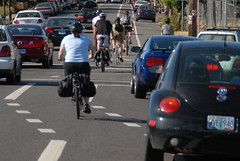
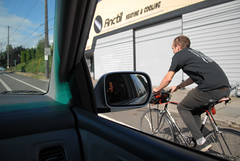
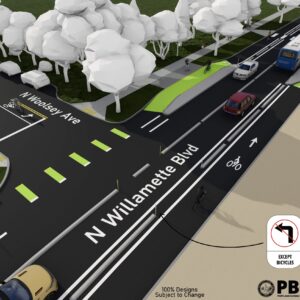
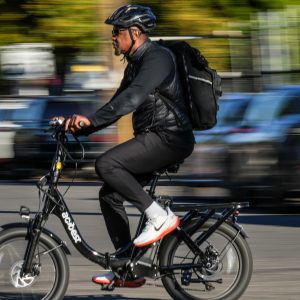
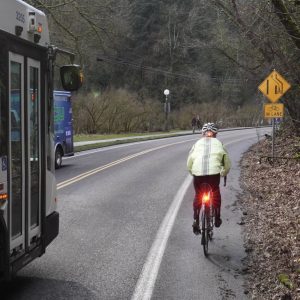
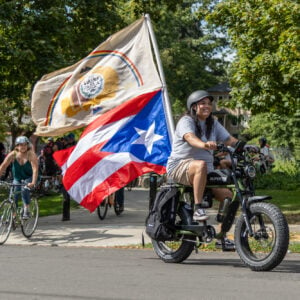
Thanks for reading.
BikePortland has served this community with independent community journalism since 2005. We rely on subscriptions from readers like you to survive. Your financial support is vital in keeping this valuable resource alive and well.
Please subscribe today to strengthen and expand our work.
As long as it remains just a semantics issue I guess it’s a way to move forward without ruffling too many feathers. Yes, it’s placating some small-minded car drivers that fail to see how the they’ll benefit from a safe bikeway. And of course if changing the title leads to the project loose sight of the biking communities end goals it could clearly be a downfall. But if it gives us a safer bike lane on Williams and reduces resistance within the community in the process how terrible is it really?
This is a brilliant way to address the issue! I’ve always tried to explain to people that increasing safety for people on bikes can’t focus solely on bike-only infrastructure. Bicyclists won’t be safe if pedestrians don’t know where to walk, or if motorists aren’t clear on where they should be looking for pedestrians and bicyclists.
Taking a wider look at the needs of all types of road users improves the safety and ease of travel for everyone.
Missing from your commentary is the responsibility of cyclists in regards to the other modes.
I think it makes perfect sense that the focus of Portland’s upcoming flagship bikeway projects not be exclusively on bikes. After all, the theme of the Portland Bike Plan for 2030 is, “It’s not just about the bicycle,” right?
Of all the projects proposed in 2011, this project will serve as an opportunity to put the city’s own ambitions to the test. Are we absolutely serious about livability, walkability, bikability and sustainability? If so, we’ll see it come to fruition with this project.
I’d encourage everyone to vote early and often in support of this project, and highlight the issues that matter most to you.
At least one bikeportland reader is on the SAC for this project. I think it makes a ton of sense to look at it from an all-modes perspective. After all, we all walk and most of us drive sometimes. with 2 frequent-service bus lines running down this corridor, these vehicles also interact. A complete solution will address all of these issues.
i applaud a complete approach. it’s not just words; it’s the right thing to do.
Semantics aside, I like the approach. The North Williams corridor is not even close to being built out yet, and as new commercial and higher density residential uses go in, it’s going to be a draw for more traffic of all kinds. Doing this comprehensive approach on the front end is going to help avoid making this the failed cluster that other areas like NW 23rd or SE Hawthorne are.
the city had the same opportunity on Hawthorne Blvd. in the late 90s but PBOT and the Hawthorne Blvd. Business Association opted for maintaining the status quo.
The worst 10% endanger all road users. Very sensible way to move forward.
If PBOT and Sam Adams wanted to distance themselves from cycling, wouldn’t they just leave it the way it is? I enjoy the work and the reporting you do on this website, but lately you’ve really been digging to twist everything around as an attack on cycling. This is a road that already has a nice, yet crowded, bike lane, and the City is starting a project to improve it even more and make it safer for everyone. Yet you somehow think that might be a negative for cycling because of the wording?
Please take it down a notch. Save the negative stuff for when you really have to cry ‘Wolf!’.
Mausy,
In your rush to criticize me (nice name btw!), I think you’ve misread my story. I absolutely did not write, nor do I feel its a correct assumption to make that this story is an attempt to “twist everything around as an attack on cycling.”
Did you read in the story above where I noted that I like the approach PBOT is taking here?
To clarify, I like this approach. However, I feel it’s my job to share background on why PBOT makes the decisions they make and what the thinking is behind them.
What you interpret as “negative stuff” I see as merely trying to add context and a bit of depth to what’s going on here.
Thanks for your comment.
Thanks Jonathan. I appreciate your response. I just want to change a lot of the “us vs. them” attitude that exists in the cycling world, and save the energy for when cycling really is being attacked.
Keep up the good work.
Am I alone in thinking that Williams is already one of te safest streets to bike on in the city? Seems that way to me at least. There is only one direction of traffic, a slow speed limit for cars, plenty wide bike lane, low motor traffic, and tons of bike traffic for bike visibility. I guess it could be improved for pedestrians, but I feel like the bike infrastructure here is pretty amazing. Living the SW, I would love to have something like the Williams route here.
Dave, you’re right, Williams works well in a lot of ways. But certainly we can do better!
Some improvements for bikes off the top of my head:
– More capacity for bikes (ride this during rush hour and you’ll see what I mean)
– Door-zone buffer (get doored here and you’ll see what I mean)
– Slowing auto speeds
– Separation from auto traffic, to induce more ridership
– Designing a solution that avoids the bus/bike leapfrog
I avoid williams because it feels dangerous to me. the high bike traffic combined with a narrow bike lane and unreasonably fast car traffic, with a bus thrown in makes riding on williams a stressful experience. I much prefer interstate mainly because the opportunity to get hit seems much lower, and the “hill” keeps the bike traffic lower.
I agree with davemess! I always think more bike and pedestrian infrastructure is good, and people should take money where they can. And getting the most buy-in from the many riders on Williams is a smart move for the city. In a way, perhaps, if you can get very high mode-share in certain areas by massively improving infrastructure, perhaps this will create political will to do this more widely. Still, I can’t help noticing that once again infrastructure is following money rather than being fairly apportioned. I’m thinking of Rockwood where there are no parks to play in and though there are bike lanes, you risk your life to ride them.
I’d counter that infrastructure is following demand in this case. After the Holgate ‘incident’ I can see why PBOT would target an area with high bike traffic thats only expected to increase. No NoPo residents will be able to flip out and say that the facilities go unused and are therefore a waste of money.
Do we want PBOT’s efforts to be fair, or effective? You can’t just force new ideas on people overnight, but if you take what’s already working and expand it, people have time to adapt.
Hooray for Michelle, Ellen, and others at the City for spearheading this more inclusive approach. Go, team!
I agree with Davemess too.
The real problems on this route can be fixed by enforcement, not a redesign.
The serious issue that I see is the bus leapfroggin.
They don’t seem to hold back, or sped up, but just keep doing it block after block after block..
And of course the crosswalks are largley ignored, but not as bad as over here in the Couv..
Once again, a noticeable police presence and enforcement can help these problems…
Encorcement is a short-term, temporary solution, and with a department that has had major budget cuts, there is not increased capacity, so you could get enforcement here for a week, then it will move somewhere else.
Changes at the design level are much more effective. Kudos to PBOT for pushing forward in that regard!
and crappy engineering design is forever….
I suspect the actual engineers have a different opinion (and knowledge base) than you.
In response to davemess, Williams has a 30 mph speed limit that is almost universally ignored. I spend 40 plus hours a week on Williams and I see cars doing 40-50 mph all the time. I agree that it’s a pretty good bike route but it’s also heavily used. I’ve talked to many cyclists who avoid Williams during the peak season because it feels too crowded. They would rather take Interstate/Greeley/Mississippi than deal with heavy bike traffic.
I think the City learned its lesson from the Bike Boulevards/Neighborhood Greenways fiasco, where a lack of thoughtful PR led to a harsh backlash against one of the best ideas in the last 5 years. When people’s tax dollars are being spent, it’s important to highlight across-the-board benefits for the whole community. If the improvements are presented as a “bikeway project,” you risk losing the support of non-cyclists who will see it as catering to a special-interest group.
I’m glad the project will include provisions for safer pedestrian crossings, though I’d like to hear more about how they plan to address the lack of crosswalk courtesy. I applaud the thoughtful approach to this project, both in its scope and semantics.
Williams is a bit of a victim of its own success. It is part of my everyday year-round bike commute and I have had quite a few problems riding it. Besides the motor vehicle problems like leap-frogging and dooring, I have also had trouble with other people on bikes. For example, I have had my bars clipped by someone passing too close and been cut off to the point of having to lock up my brakes by another bike cutting directly in front of me. On a lot of summer days I will take Rodney and deal with the hassle of frequent stop signs.
Off the top of my head I wonder if they could eliminate car parking on the west side of the street and put an extra wide bike lane there instead. There likely would still be room for 2 lanes of motor vehicle traffic and parking on the east side. This would keep further separation between bikes and buses as well as eliminate the threat of being doored.
I guess my real question is: why do we need 2 car lanes? a double-wide bike lane would acknowledge the bike highway that this route is
let the motorists use MLK
Yep, and eliminate left hand turns and cross traffic at intersections that don’t have lights.
Yes please. I live on Fargo (a bit South of Fremont) and during the evening commute, traffic coming off of 405 tends to use Cook and Fargo to get to MLK. And despite being narrow, residential roads with parking on both sides, people love to just fly through there at high speeds.
I would just like to know how the City of Portland plans to increase their rider share, if they don’t increase access for bikes in other parts of the city. I am glad for your remodel on Williams,even though I am not sure if this will add new people to bike.
don’t worry, all the people from the rest of the country that move here after seeing ‘Portlandia’ will boost the number of new cyclists significantly…
Is there a greenway parellel with Williams for those that don’t like riding on a busy street? They make the Concord greenway just a block off of Interstate for people like that. Do they expect children to ride Williams? There may be some parents who might oblect to that.
Rodney (one block East) is not officially recognized as a bike route, but is certainly suitable for children/families. Only problem I’m aware of is the crossing at Fremont where Rodney jogs East about 100 ft.
we have to do both! I see us making an example of what we want on Williams, getting this to lead to more folks in other neighborhoods to copy us. Growing ridership everywhere doesn’t mean we can’t make the big improvements where we already have high ridership. Williams is a natural place to start as folks seem to embrace biking on that street more than almost any other non-bridge route
O, I forgot that the trickle down effect is what the rest of the city is waiting for. Thanks for the heads up on that Allan. I am sure the bike lanes will trickle down, right after the economy trickles down.
I agree that N.Williams is a victim of it’s own success. I’m ambivalent about changing the street: Yes, I want it safer, but PBOT designs are often unsatisfactory (e.g. SE Couch to Burnside curve)
I hope this project will address signal timing on Williams.
Lights are timed too fast for cyclists, meaning you tend to hit red, red, red, red at every signalized intersection.
It’s frustrating. I stop at all lights, but many cyclists get impatient with how many red lights there are, & have a tendency to run them as a result. Not good for bicycling’s reputation.
Plus, given the number of vulnerable roadway users on this corridor (very high bike and ped activity), having motor traffic slow down a wee bit can only be a good thing.
I second this! I get extremely frustrated riding on Williams and on Vancouver northbound because I seem to just miss every light. Timing the lights more like downtown, where the speed limit is lower, would be a big help for cyclists and would help slow down other vehicle traffic.
This is great news and I hope this approach is the model for a variety of other public ROW projects that will effectively implement the Bike Master Plan. Clearly there are some smart folks working on this project. But, hm… “North Williams Traffic Operations Safety Project.” (NWTOS). Kind of a mouthful and about as sexy a whiff of Tri-flow. But perhaps this a clever strategy too… a project name that will certainly weed out the fly-by-night, ego-swollen grandstanders while attracting those pragmatic, under-appreciated Portlanders with the longer attention spans and the patience and persistence to wade through all the boring but important details. Let’s hope.
As a resident of the Boise area, I wanted to clarify something ‘…thriving African American community?” My long-time neighbors are African American and along with myself, question “thriving”. Gentrification doesn’t happen to “thriving” communities… Go better bike lanes, regardless of Portland’s uber PC beliefs!!!